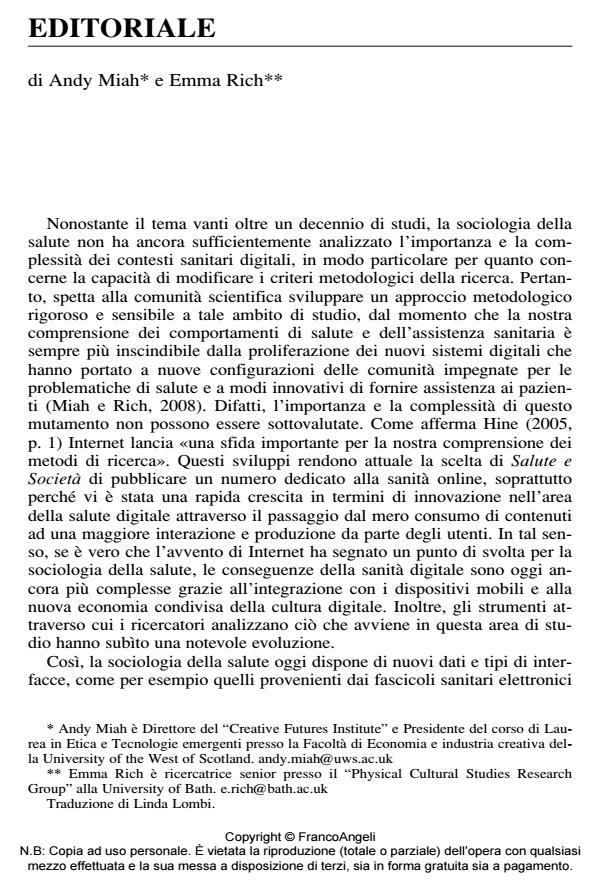Editoriale
Titolo Rivista SALUTE E SOCIETÀ
Autori/Curatori Andy Miah, Emma Rich
Anno di pubblicazione 2014 Fascicolo 2014/3 Lingua Italiano
Numero pagine 7 P. 11-17 Dimensione file 497 KB
DOI 10.3280/SES2014-003001
Il DOI è il codice a barre della proprietà intellettuale: per saperne di più
clicca qui

FrancoAngeli è membro della Publishers International Linking Association, Inc (PILA)associazione indipendente e non profit per facilitare (attraverso i servizi tecnologici implementati da CrossRef.org) l’accesso degli studiosi ai contenuti digitali nelle pubblicazioni professionali e scientifiche
- Bauer K. (2004). Cybermedicine and the moral integrity of the physician-patient relationship. Ethics and Information Technology, 6(2), 83-91. DOI: 10.1023/A:101000150496
- Castells M. (2010). The Rise of the Networked Society: The Information age: Economy, Society and Culture. Oxford, Wiley Blackwell. Vol 1, 2nd Edition
- Chan M. (2013). Mobile phones and the good life: Examining the relationships among mobile use, social capital and subjective well-being, New Media & Society, Vol XX(X) 1-18. DOI: 10.1177/146144481351683
- Colliste G. 2002). The Internet doctor and medical ethics: Ethical implications of the introduction of the Internet into medical encounters, Medicine, Health Care and Philosophy 5: 121-125, 2002. DOI: 10.1023/A:10160830214
- Fox S. (2006). Online Health Search 2006, Pew Internet & American Life Project, disponibile online: www.pewinternet.org/files/old-media/Files/Reports/2006/PIP_Online_Health_2006.pdf [Ultimo accesso: 20 Aprile 2014]
- Fox S., Duggan M. (2012). Mobile Health 2012, Pew Internet & American Life Project, disponibile online: www.pewinternet.org/files/old-media//Files/Reports/2012/PIP_MobileHealth2012_FINAL.pdf [Ultimo accesso: 19 aprile 2014]
- Hine C. (2005). Virtual methods and the sociology of Cyber-Social-Scientific knowledge. In Hine C. (Ed.). Virtual methods: issues in social research on the internet. Oxford: Berg, 1-13
- Kozinets R.V. (2002). The Field Behind the Screen: Using Netnography for Marketing Research in Online Communities. Journal of Marketing Research, February 2002, Vol. 39, No. 1: 61-72. DOI: 10.1509/jmkr.39.1.61.1893
- Lupton D. (2012). M-health and health promotion: The digital cyborg and surveillance society. Social Theory and Health. 10, 229-244. DOI: 10.1057/sth.2012.
- Livingstone S., Helsper E. (2007). Gradations in digital inclusion: Children, young people and the digital divide. New Media and Society, 9(4): 671-696.
- DOI: 10.1177/146144480708033
- Miah A., Rich E. (2008). The Medicalization of Cyberspace. London & New York: Routledge
- Nettleton S., Burrows, R. (2003). E-scaped medicine? Information, reflexivity and health. Critical Social Policy, 23(2), 165-185. DOI: 10.1177/0261018303023002003RupertE.,LawJ.,SavageM.(2013).Reassemblingsocialsciencemethods:thechallengeofdigitaldevices.Theory,CultureandSociety:SpecialIssuesontheSocialLifeofMethods.30(4):22-46.doi:10.1177/026327641348494
- Swan M. (2012). Health 2050: the realization of personalized medicine through crowdsourcing, the Quantified Self, and the participatory biocitizen, Journal of Personalized Medicine, 2: 93-118. DOI: 10.3390/jpm203009
Andy Miah, Emma Rich, Editoriale in "SALUTE E SOCIETÀ" 3/2014, pp 11-17, DOI: 10.3280/SES2014-003001